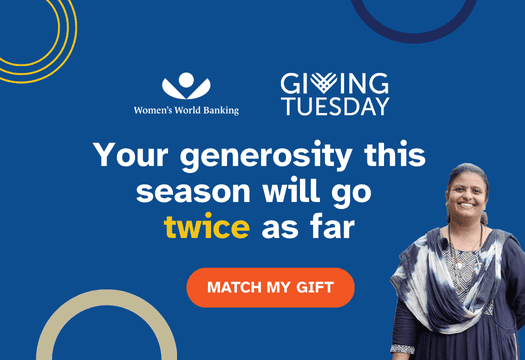By Mary Ellen Iskenderian, President & CEO, Women’s World Banking and Dhivya O’Connor, CEO, Cherie Blair Foundation for Women
Politics aside: keep momentum in women’s digital financial inclusion
2024 is a mega year for elections across the globe. Almost a quarter of the world’s population is heading to the polls in more than 70 countries, approximately 4 billion people.
Within this political upheaval – and the policy changes that potentially come with it – there is a real risk that the important progress that many countries have made in bringing women into the formal digital financial system may go into reverse. National governments, whether newly formed or incumbent, must keep their attention on ensuring that women can participate on an equal footing in the digital world.
Ahead of the 79th session of the United Nations General Assembly (UNGA) taking place in New York City next week,where world leaders will come together under the theme of ‘Leaving no one Behind’ to discuss the most pressing political, economic, social and environmental issues of our time, we are asking: why should women’s digital financial inclusion (WDFI) be at the top of the agenda?
The answer? It’s simple: Three-quarters of a billion women globally are excluded from the formal financial sector. They are also substantially less likely than men to own and use mobile phones and the internet, limiting their access to digital financial services. These financially excluded women are unable to reach their full economic potential which acts as a drag on gross domestic product (GDP) growth. In addition to the evident impact on growth, closing the gender gap in digital financial inclusion is critical to economic equity – a fundamental element in women’s human rights – and as such must be prioritized by all governments.
Financial empowerment allows women to enjoy independence, choices and security; by investing in their own futures, they can better cope with shocks including those related to climate change, and take advantage of business and education opportunities — all of which contribute to economic growth.
Supporting women entrepreneurs
Having access to the full suite of financial products and services is particularly critical for women since nearly 20% of working-age women in developing economies are entrepreneurs. Their businesses create income for families that supports education and wellbeing; they also provide services, create jobs, and introduce innovation in their communities.
Women-led MSMEs (micro, small and medium-sized enterprises) are a key enabler of economic growth and stability. It is estimated that if women and men participated equally as entrepreneurs, global GDP could rise by up to 6% – boosting the global economy by US$2.5-5 trillion annually. That’s a platform that any politician can get behind!
There is an enormous (and growing), yet often unmet, demand from women entrepreneurs for digital tools and services for business. But these products and services, and the policies underpinning them must be designed to meet women’s specific needs so they can achieve business success.
How can newly elected and incumbent officials focus their efforts to ensure WDFI progresses opportunities for women entrepreneurs? They can:
- Center women in the decision-making process when making systemic policy decisions;
- Collect, analyze and utilize gender-disaggregated data to inform policy;
- Ensure women have the knowledge and skills to use digital financial services, and are protected as consumers; and
- Collaborate with the private sector and civil society to deliver initiatives that ensure women have access to digital financial services on their terms.
Multistakeholder partnerships are key
Indonesia is one example of a nation that has kept up WDFI momentum while transitioning to a new government. These issues remain at the forefront of the new administration’s agenda, and policy continuity through the recent election has helped to build on earlier progress. This is an economic imperative in a country where two-thirds of the 64.2 million MSMEs are women-owned, and where gender parity in e-commerce entrepreneurship would contribute an additional US$11 billion annually to GDP.
Indonesia’s National Council on Financial Inclusion has developed specific policies to improve women entrepreneurs’ access to digital financial services. These stress the need for partnerships between government, financial service providers, the e-commerce sector, and development partners.
Through the WDFI Advocacy Hub, Women’s World Banking has been working with the Indonesian government to advance women’s digital financial inclusion, such as through capacity-building initiatives for women’s groups.
In addition, Women’s World Banking and the Cherie Blair Foundation for Women are collaborating with a common objective of accelerating progress in WDFI and sharing best practices and gender-focused research.
Leave no woman behind
As much of the world heads to the polls, and as world leaders head to New York City for UNGA, it is critical that WDFI transcends partisan politics and remains a priority for policymakers, regulators and governments, regardless of the political environment.
All actors need to work together – policymakers, regulators, governments, financial services providers, and civil society organizations. We need to speak with a single voice to advocate for tailored financial products, consumer protection, and inclusive policies.
We hope you’ll join us to help close the gender gap and continuously campaign for women’s digital financial inclusion.
Resources
- Why women entrepreneurs?
- Bridging the Divide: Women, Tech and Business Success
- Report: Building Digital Finance Solutions for Women E-Commerce Entrepreneurs: A Demand-Side Exploration in Indonesia
- The Women’s Digital Financial Inclusion Advocacy Hub
- Report: Revolutionizing Product Design in Financial Services
- Policy Brief: Making Financial Products and Services Work for Women
- Advancing Women-Led MSMEs through Digital Financial Inclusion




